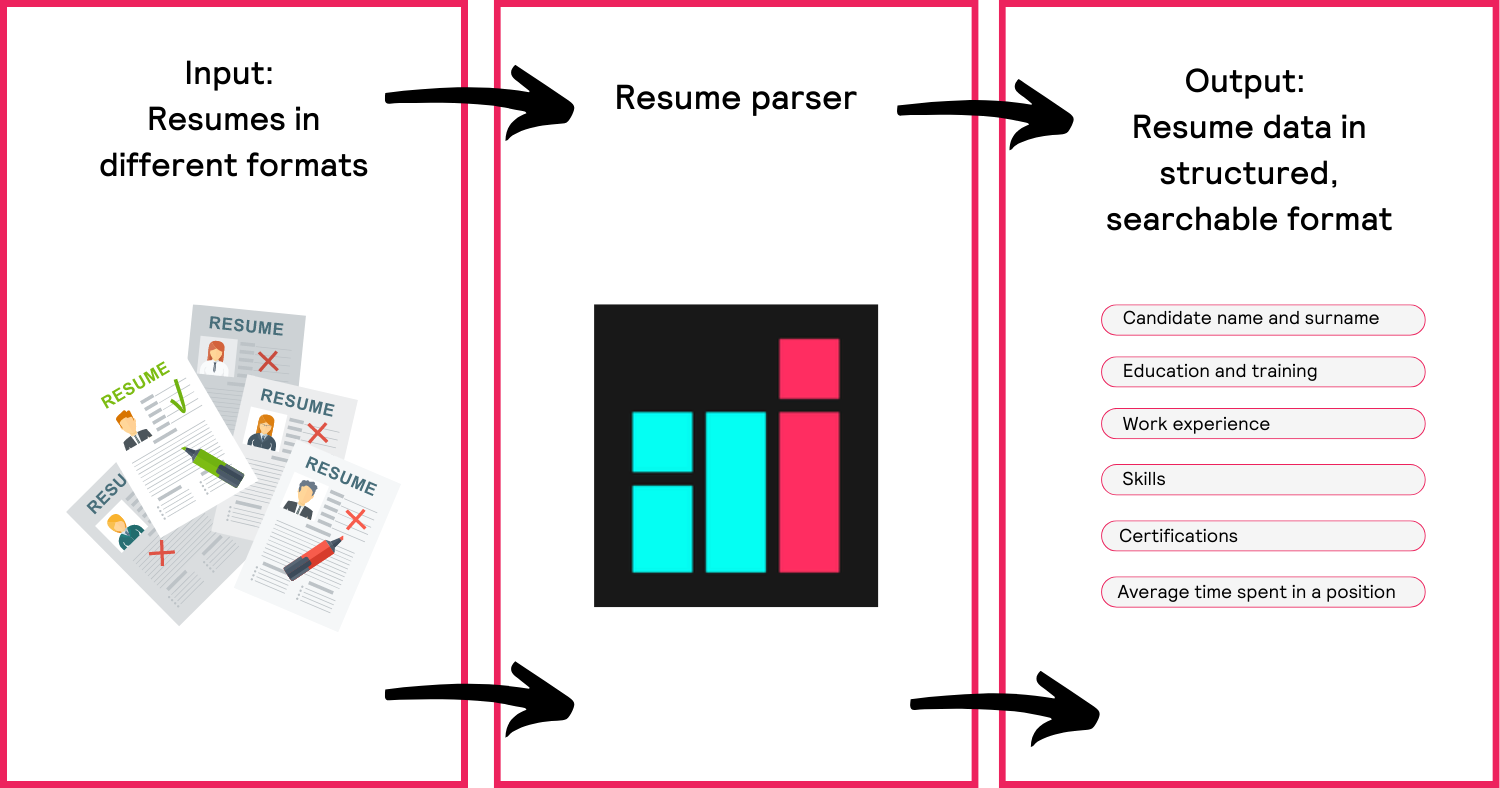Resume parsing is the process of taking candidate information from CVs and turning it into resume data. In other words, resume parsing software reads all the resumes in detail, understands them, and pulls out information from them.
Later, that information can be used to classify candidates, and even rate them. It helps recruiters find their ideal candidate.
Recruiters, HR professionals, and hiring managers are now using CV parsing tools to simplify the hiring process and streamline their workflows.
Let's say that an average online job posting means over 250 resumes get submitted. In that large pool of resumes, there is a huge mix - there are the perfect candidates; those that hope to level up in their career (but aren't quite there); and also those who did a digital equivalent of scribbling their CV on a napkin.
A busy HR doesn't have the time to process this in detail. They need to shortlist the candidate database quickly. But, the first step of doing that is actually getting the information out of the CVs. That's where resume parsing software comes in.
How Does Resume Parsing Work?
Resume parsers like ours leverage artificial intelligence and deep learning models to provide accurate, categorised data to recruitment teams. Once the CVs are uploaded, the machine learning model processes the information, automatically detecting common resume fields. It then sorts the information according to data type.
The recruiting software improves over time, learning from its mistakes and categorising data more accurately as it processes more CVs. That's the beauty of using AI as your parsing system. It classifies your data with human accuracy but it never gets tired.

If you give a human a menial task like this, they will probably start making mistakes over time, and that's normal. With AI, it only gets better with time. The more data it sees, the better its parsing process becomes.
So, Why Should You Parse Resumes, Again?
There are many benefits to using resume screening software:
- It improves the candidate experience
- It saves time and money on your recruiting process
- It leaves less room for human-made mistakes
- It automates the applicant screening process
- It can potentially build a goldmine of data
- It boosts your employer's branding efforts
If you take into account that employers don't spend more than a couple of seconds on each resume, it's hard to imagine that this process can be sped up. After all, it's just a couple of seconds, right?
Yes.
But how would you rate the accuracy of such a screening process? Is it perfect?
Exactly.
There's not much you can see from a resume for such a short time, and you're risking missing out on some amazing candidates.
Let's say it takes you 2 hours to do this initial screening, looking at one resume at a time, dedicating just a couple of seconds to each one.
Basically, a resume parser does that several-second job for you even faster, and it gives you a short list of candidates to look at. So, you will spend the same amount of time on your hiring process, but you will do this better and you'll be more focused.
For example, you won't spend two hours, but an hour and a half on this process, but you'll be able to dedicate a decent amount of time to really study each resume.
Surely, people hired people without resume parsers before, right?
Yes, of course, they did. But now they do it better and faster.
What Did People Do Before Resume Parsing Software?
Before resume parsing, an HR manager would put up a job post, and then go through candidate's resumes manually.
The hiring process involved reading resumes and looking for relevant skills and appropriate educational background in the hope to find the best candidate.
This outdated method of reading through every single CV has been replaced with using resume extraction tools to gather candidate data on each applicant.
Resume parsing technology helps recruiters organise relevant information into a number of categories. These may include:
- work history
- skills
- job titles
- certificates
- qualifications
The result is structured data that can be read at a glance to easily match the most suitable candidates to the job description for a given position.
Who Uses Resume Parsers in 2022?
Resume parsing is becoming an industry standard. The job market is becoming very much job-seeker-oriented, and that means you need to start thinking about your employer branding. Organising a smooth and convenient job application process is a must.
In 2022, long gone are the days in which you get your candidates to upload their CV and type in the information from their resume into your system one more time. Today, it is expected for your company to have the software to do that for you.
Once something becomes an industry standard, incorporating it into your process becomes a necessity, rather than a novelty. Resume parsing software is precisely that.
Anyone who is in charge of hiring can benefit from adding resume parsing into their recruitment processes. The practice is widespread amongst job boards, hiring managers, internal HR teams, recruiters, and staffing firms alike.
What Is Blind Resume Parsing?
Another popular trend amongst HR teams is blind recruitment. This is a process where the people selecting who to interview don’t have any personal information about the applicants, such as name, age, and photos. The purpose of this is to prevent bias in the recruitment process.
Resume redaction software makes the management of this type of process so much easier. Integrate a resume parser with your applicant tracking system to simplify the administration of a blind recruitment process.
How Accurate Is Resume Parsing?
Resume parsers are typically up to 87% accurate. We suggest choosing a resume parsing tool trained on thousands of CVs to gain the most accurate results. Affinda’s resume parsing tool is well-known as one of the most accurate on the market, making it a popular choice amongst recruitment teams.
We offer a free resume parsing tool on our website that allows you to upload some CVs and test out the accuracy for yourself: https://www.affinda.com/resume-parser/.
This is an excellent way to see if using a resume parser might be a helpful tool for your organisation. And if you find the free version useful and want to upgrade, reach out and our team of experts will be happy to help you.











